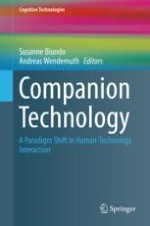2017 | OriginalPaper | Chapter
17. Analysis of Articulated Motion for Social Signal Processing
Authors : Georg Layher, Michael Glodek, Heiko Neumann
Published in: Companion Technology
Publisher: Springer International Publishing
Activate our intelligent search to find suitable subject content or patents.
Select sections of text to find matching patents with Artificial Intelligence. powered by
Select sections of text to find additional relevant content using AI-assisted search. powered by
